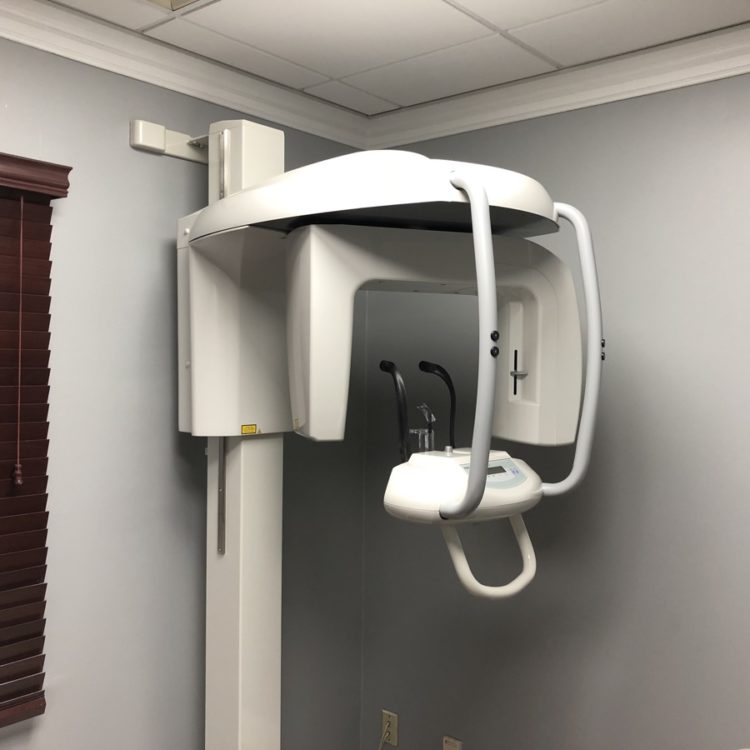Digital X-Rays
Traditionally, dentists use x-rays to find out what's going on below the surface, developing them in a darkroom full of chemicals, and examining the resulting films on a special light board.
Digital radiography entirely outmodes that cumbersome process. Now, a tiny sensor placed in the mouth acts like a miniature VCR camera with an x-ray sensitive chip, exposing you to 50%-90% less radiation exposure than with traditional x-ray techniques. The resulting highly detailed image of your mouth is almost instantaneously translated onto our computer screen, carrying with it all the conveniences of other digitized images. We can rotate it, magnify it, adjust it for contrast, and even color-code it for educational purposes. Because it helps our patients clearly understand the root issues behind their dental health, we're able to work together to determine the very best treatment options for each case.

iTero Scanner
The 3D iTero Scanner is one of a new breed of technology that is revolutionising dentistry.
These types of advanced intra-oral scanners work by capturing thousands of pictures of the inside of your mouth, and then assembling them into an incredibly accurate 3D model of your mouth, teeth and gums.
This allows Dr. Poelman to fully assess and inspect every aspect of your condition, and accurately plan out the stages of your treatment. Although early intraoral cameras and scanners left a lot to be desired, the latest generation of scanners are far superior. Our staff will use a specially-adapted, hygienic scanner called a ‘wand’ to take thousands of pictures.
The scanner uses medical-grade low-radiation lasers to take up to 20 pictures a second of your teeth. Our staff will gradually move and rotate it to be sure to get a complete scan of your whole mouth.
As they do this, gradually a 3D model of the inside of your mouth will emerge on the iTero screen. Usually this whole process takes less than 10 minutes.
With this technology, we can then use this 3D model to assess your needs, determine what treatment options are available to you, and which will likely give you the most desirable outcome.
Sterilization and Patient Safety
Our office uses state of the art sterilization to ensure patient safety. Sterilization and disinfection are the basic steps in instrument processing and surface asepsis. Sterilization refers to the use of a physical or chemical procedure to destroy all forms of microorganisms, including the highly resistant spores.
We use Rapid Steam Autoclave at 275º F(35psi), for 15-20 minutes
First, the instruments are prepared for the sterilization process. Patient debris and fluids are removed by placing the instruments in 3.2% glutaraldehyde for 40 minutes. Following this pre-disinfection step the instruments are transferred to an ultrasonic cleaner for another 15 minutes. Then the instruments are rinsed, dried, placed in self sealing sterilization pouches and sterilized in the autoclave. Instruments which can not be heat sterilized, are immersed in 2% glutaraldehyde for 10 hours to cold sterilize.
We use Biological, Chemical and Mechanical indicators to monitor our sterilization process.
Using bacterial spores to monitor the sterilization process is referred to as biologic monitoring (or spore-testing), and the bacterial spores used for monitoring the sterilization process are referred to as biologic indicators (BIs). Of the three methods, biologic monitoring is regarded as the most valid for monitoring the sterilization process, for it uses live, highly resistant bacterial spores.
We biologically monitor our sterilizer once a week to ensure complete sterilization using spore strips and keep accurate records for our monitoring. These strips are enclosed in a glassine envelope and processed through the sterilizer. They are then sent to our spore testing center where they are tested for live spores.
Chemical monitoring involves using chemical indicators (CIs) that change color or form when exposed to specific high temperatures or to the sterilizing conditions within a sterilizer. This is referred to as chemical monitoring (or process monitoring). We use sterilization pouches that have special marking that change color when subjected to sterilizing temperatures.
Mechanical monitoring involves observing and recording the physical aspects (e.g., temperature, pressure or time) of the cycle when the sterilizer is being operated. Our Sterilizer is serviced regularly to ensure proper functioning.
Top 5 Services
Invisalign Braces
A modern solution of straightening your teeth through clear braces, made specifically to fit your mouth.
Porcelain Veneers
Veneers are an ideal cosmetic solution for everyone who desires a beautiful smile with minimal invasions into their teeth.
Restorative Dentistry
We work passionately toward creating the most youthful smiles for patients whose natural teeth require replacement.
Cosmetic Dentistry
A beautiful smile contributes to a better mood, it affects self-esteem, and it allows us to make a good impression on others.
Teeth Whitening
Professional teeth whitening allows us to brighten your smile and wipe away stains.

The Poelman Membership Plan is an annual reduced-fee savings plan for families and individuals without dental insurance coverage that allows all Members to receive quality dental services at greatly reduced prices. Unlike conventional insurance plans, with PMP there are no deductibles, no yearly maximums, and no waiting periods to begin treatment. PMP benefits coverage begins immediately on plan registration.
Benefits include:
• Up to two standard teeth cleanings with fluoride applications per year
• Up to two complete dental examinations with oral cancer evaluations
• Digital Images for annual exam
• A 20% reduction in fees on all dental procedures
• A 50% reduction in fees on sealants up to age 18
• A 50% reduction in fees on custom bleaching trays
Benefits include:
• Up to four standard teeth cleanings with fluoride applications per year
• Up to two complete dental examinations with oral cancer evaluations
• Diagnostic digital images for annual exam
• A 25% reduction in fees on all dental procedures
• A 50% reduction in fees on sealants up to age 18
• A 50% reduction in fees on custom bleaching trays



